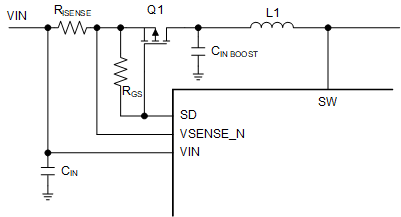SNVSB83B June 2019 – January 2020 LP8867-Q1 , LP8869-Q1
PRODUCTION DATA.
- 1 Features
- 2 Applications
- 3 Description
- 4 Revision History
- 5 Device Comparison Table
- 6 Pin Configuration and Functions
-
7 Specifications
- 7.1 Absolute Maximum Ratings
- 7.2 ESD Ratings
- 7.3 Recommended Operating Conditions
- 7.4 Thermal Information
- 7.5 Electrical Characteristics
- 7.6 Internal LDO Electrical Characteristics
- 7.7 Protection Electrical Characteristics
- 7.8 Current Sinks Electrical Characteristics
- 7.9 PWM Brightness Control Electrical Characteristics
- 7.10 Boost and SEPIC Converter Characteristics
- 7.11 Logic Interface Characteristics
- 7.12 Typical Characteristics
-
8 Detailed Description
- 8.1 Overview
- 8.2 Functional Block Diagram
- 8.3
Feature Description
- 8.3.1 Integrated DC-DC Converter
- 8.3.2 Internal LDO
- 8.3.3 LED Current Sinks
- 8.3.4 Power-Line FET Control
- 8.3.5 LED Current Dimming With External Temperature Sensor
- 8.3.6 Fault Detections and Protection
- 8.4 Device Functional Modes
- 9 Application and Implementation
- 10Power Supply Recommendations
- 11Layout
- 12Device and Documentation Support
- 13Mechanical, Packaging, and Orderable Information
8.3.4 Power-Line FET Control
The LP886x-Q1 has a power-line FET control feature. It has a control pin (SD) for driving the gate of an external power-line P-Channel MOSFET. This feature grants LP886x-Q1 the ability to immediately cut-off the power part of backlight system when failure occurs, protecting other parallel power systems from being impacted. In addition, the feature could smooth the inrush current during powering-up by turning on the power-line FET gradually. In SOFT START state, the SD pin slowly increases the sink current until it reaches 230 μA. An example schematic is shown in Figure 14.
The value of RGS should follow the rules below
- ISD_MAX × RGS should be less than the power-line FET's maximum acceptable Source-Gate voltage
- ISD_MIN × RGS should be greater than the minimum power-line FET's Source-Gate voltage which could ensure a low On-State Resistance.
A 20-kΩ RGS is chosen in typical application which generates a 4.6 V difference on power-line FET's Source-Gate voltage.
 Figure 14. Power-Line FET Control Schematics
Figure 14. Power-Line FET Control Schematics The LP886x-Q1 turns off the power-line FET and prevents the possible boost and LEDs leakage when the device is disabled or in FAULT RECOVERY state.
Power-line FET control is an optional feature. Leave SD pin NC and don't use power-line FET when this feature is not needed.